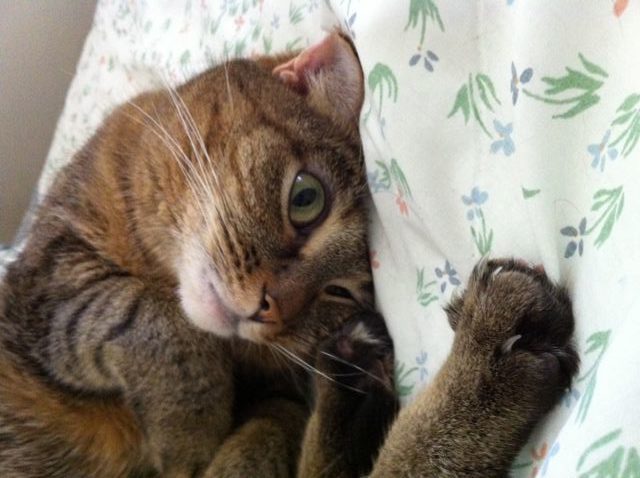Nobody likes to read a long page of text. In fact, the quickest way to make users click the Back button is by presenting them with endless paragraphs on your blogsite. Yet, the fastest way to catch their eyeballs is with a striking picture.
When at a loss, use a cute kitty picture. People love animals.
Every blog post worth reading deserves a good clear image above the fold, right under the Headline. If you write about a place, a thing or a person, your readers need a visual image immediately.
It’s what they expect, so whether it’s a literal image or symbol, you have to give them pictures. There’s no two ways about it.
How many pictures to post depends on how fast a page loads. Nobody wants to stare at those little question-mark boxes, waiting for an image to appear, so you might loose viewers by loading up too big an array.
And if you have images in your Sidebars and Header you might want to go easy on the Post pictures. At Tasting Room Confidential, I have image ads in my sidebars, so I only use 1-3 pics in my posts.
Still, Hubspot Grader always nags me that it’s too much.
Here are 5 of the best ways to post photos on your blog.
Shoot photos
Everybody has a digital camera these days, so how hard is it to shoot something and download it? Here’s how to be your own photographer.
• People look great photographed near a window as the ceiling and walls help focus the rays in a Rembrant lighting style. Don’t move in too close though, unless you have a telephoto lens.
• Objects can be arranged in a stylized way and lit with natural light or on-camera flash. Close-ups are especially engaging to the eye, but make sure to set your focus for it.
• Landscapes are easy to capture, but hard to make unique. Seek the odd angle or human element.
Company media
If your blog is at all related to an industry or institution, you can go to the company website, click on the Media tab, and browse hi-quality images that they want you to use. Sometimes, there are various resolutions for each images.
I get thumbdrives of images from wineries, full of beautiful hi-res images the company paid professional photographers to shoot. You don’t have to give credit to the company that provides the image, but it’s good form.
Google Images
Google gives you lots of information on the images, thanks to the tags inserted by the photographer.
Google Images is where all well-tagged pictures reside. There are 90,500,000 results for the word, “Wine” on Google Images. If you go to the Advance Search page and scroll almost to the bottom, under Usage Rights, select “Only images labeled for reuse.” By changing that, I get 123,000 wine pictures licensed with GNU Free Documentation that I can use for free, since my blog is hardly commercial. If I was a wine seller I would select for Commercial Use and have 23,500 Google images available.
The Google Images you click on offer information on the photographers web site, or sometimes a flickr page jumps up, and from there you can negotiate with the owner online, whether your project is commercial or artistic. As long as you can prove you reached out in good faith to ask for use, a non-responding photographer can only expect you to take the image down if he or she objects to its use, especially if they signed the GNU Free Documentation license
Stock photos
There are a gazillion photo sites that offer pictures for free or for a fee. I rarely use them, but I hear iStockphoto is a good source, and of course there is Flickr, which I belong to and from which I have place an RSS Feed on my Images page. They all have their own terms to use by.
Image tags
Once you’ve saved an image on your hard drive, WordPress makes it easy to load images into the Media Gallery and it gives you lots of ways to enhance and optimize the images. In iPhoto, I save the image in the Medium format and they look good under 100 kb. In Photoshop, I save it at the same size.
It’s very important to use the Title, Alt Text, and Description Tags to your best advantage. I put in all the who/what/where keywords – not abbreviated – plus my name and site address into the Alt Text and copy that to the Description and Caption, though I delete my name and address from the Caption. Too much information.
Having an embedded Alt Text link to your blogsite will be good for your ranking as it increases your exposure across the web. On the Post page, give the image a link either to the subject’s site by embedding it in the File URL field found on the Edit Media page. The more links the better.
Thanks to all this optimization, when the image that you shot ends up on the Google Images page, users will be able to find you and ask if they can use your picture.
So, start shooting pictures of anything you will possibly write about and post photos on your blog. Your readers will appreciate it.
If you enjoyed this installment of Blogsite Studio, please subscribe below and Like it on Facebook. Cheers!

